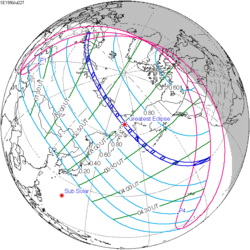Top Qs
Timeline
Chat
Perspective
Solar eclipse of October 2, 2024
Annular eclipse From Wikipedia, the free encyclopedia
Remove ads
An annular solar eclipse occurred at the Moon’s descending node of orbit on Wednesday, October 2, 2024,[1] with a magnitude of 0.9326. A solar eclipse occurs when the Moon passes between Earth and the Sun, thereby totally or partly obscuring the image of the Sun for a viewer on Earth. An annular solar eclipse occurs when the Moon's apparent diameter is smaller than the Sun's, blocking most of the Sun's light and causing the Sun to look like an annulus (ring). An annular eclipse appears as a partial eclipse over a region of the Earth thousands of kilometres wide. Occurring about 2 hours before apogee (on October 2, 2024, at 20:40 UTC), the Moon's apparent diameter was smaller.[2]
Other than Easter Island and a small portion near the southern tips of Argentina and Chile and the north of the Falkland Islands,[3] the path of the eclipse's antumbra occurred over the Pacific Ocean. The penumbra was visible from Hawaii, eastern Oceania, southern and central South America, the southwesternmost parts of Mexico (more specifically, Baja California del Sur and Jalisco), and portions of Antarctica. Approximately 175,000 people live in the path of annularity.[4][5]
Remove ads
Images
- Annular eclipse from Santa Cruz Province, Argentina
- Partial eclipse from Uruguay
- Annular eclipse from Rapa Nui (Easter Island)
- Eclipse chasers at Ahu Tahai, Hanga Roa, on Rapa Nui (Easter Island) observing the October 2024 Annular Eclipse.
Eclipse timing
Places experiencing annular eclipse
Places experiencing partial eclipse
Remove ads
Eclipse details
Summarize
Perspective
Shown below are two tables displaying details about this particular solar eclipse. The first table outlines times at which the Moon's penumbra or umbra attains the specific parameter, and the second table describes various other parameters pertaining to this eclipse.[6]
Eclipse season
This eclipse is part of an eclipse season, a period, roughly every six months, when eclipses occur. Only two (or occasionally three) eclipse seasons occur each year, and each season lasts about 35 days and repeats just short of six months (173 days) later; thus two full eclipse seasons always occur each year. Either two or three eclipses happen each eclipse season. In the sequence below, each eclipse is separated by a fortnight.
Remove ads
Related eclipses
Eclipses in 2024
- A penumbral lunar eclipse on March 25.
- A total solar eclipse on April 8.
- A partial lunar eclipse on September 18.
- An annular solar eclipse on October 2.
Metonic
- Preceded by: Solar eclipse of December 14, 2020
- Followed by: Solar eclipse of July 22, 2028
Tzolkinex
- Preceded by: Solar eclipse of August 21, 2017
- Followed by: Solar eclipse of November 14, 2031
Half-Saros
- Preceded by: Lunar eclipse of September 28, 2015
- Followed by: Lunar eclipse of October 8, 2033
Tritos
- Preceded by: Solar eclipse of November 3, 2013
- Followed by: Solar eclipse of September 2, 2035
Solar Saros 144
- Preceded by: Solar eclipse of September 22, 2006
- Followed by: Solar eclipse of October 14, 2042
Inex
- Preceded by: Solar eclipse of October 24, 1995
- Followed by: Solar eclipse of September 12, 2053
Triad
- Preceded by: Solar eclipse of December 2, 1937
- Followed by: Solar eclipse of August 4, 2111
Solar eclipses of 2022–2025
Saros 144
This eclipse is a part of Saros series 144, repeating every 18 years, 11 days, and containing 70 events. The series started with a partial solar eclipse on April 11, 1736. It contains annular eclipses from July 7, 1880 through August 27, 2565. There are no hybrid or total eclipses in this set. The series ends at member 70 as a partial eclipse on May 5, 2980. Its eclipses are tabulated in three columns; every third eclipse in the same column is one exeligmos apart, so they all cast shadows over approximately the same parts of the Earth.
The longest duration of annularity will be produced by member 51 at 9 minutes, 52 seconds on December 29, 2168. All eclipses in this series occur at the Moon’s descending node of orbit.[7]
Metonic series
The metonic series repeats eclipses every 19 years (6939.69 days), lasting about 5 cycles. Eclipses occur in nearly the same calendar date. In addition, the octon subseries repeats 1/5 of that or every 3.8 years (1387.94 days). All eclipses in this table occur at the Moon's descending node.
Tritos series
This eclipse is a part of a tritos cycle, repeating at alternating nodes every 135 synodic months (≈ 3986.63 days, or 11 years minus 1 month). Their appearance and longitude are irregular due to a lack of synchronization with the anomalistic month (period of perigee), but groupings of 3 tritos cycles (≈ 33 years minus 3 months) come close (≈ 434.044 anomalistic months), so eclipses are similar in these groupings.
Inex series
This eclipse is a part of the long period inex cycle, repeating at alternating nodes, every 358 synodic months (≈ 10,571.95 days, or 29 years minus 20 days). Their appearance and longitude are irregular due to a lack of synchronization with the anomalistic month (period of perigee). However, groupings of 3 inex cycles (≈ 87 years minus 2 months) comes close (≈ 1,151.02 anomalistic months), so eclipses are similar in these groupings.
Remove ads
See also
Notes
- The times listed for this location occur on October 3, 2024, local time.
References
External links
Wikiwand - on
Seamless Wikipedia browsing. On steroids.
Remove ads
















































































































